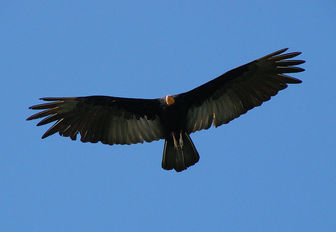Greater Yellow-headed Vulture
The Greater Yellow-headed Vulture feeds on carrion and locates carcasses by sight and by smell, an ability which is rare in birds. It is dependent on larger vultures, such as the King Vulture, to open the hides of larger animal carcasses, as its bill is not strong enough to do this. Like other New World Vultures, the Greater Yellow-headed Vulture utilizes thermals to stay aloft with minimal effort. It lays its eggs on flat surfaces, such as the floors of caves, or in the hollows of stumps. It feeds its young by regurgitation.

Original source: Cathartes melambrotusUploaded by Richard001
Author: Sidnei DantasCamera location
The Greater Yellow-headed Vulture is classified as Least Concern. Does not qualify for a more at risk category. Widespread and abundant taxa are included in this category.
The Greater Yellow-headed Vulture feeds on carrion and locates carcasses by sight and by smell, an ability which is rare in birds. It is dependent on larger vultures, such as the King Vulture, to open the hides of larger animal carcasses, as its bill is not strong enough to do this. Like other New World Vultures, the Greater Yellow-headed Vulture utilizes thermals to stay aloft with minimal effort. More
Greater Yellow-headed Vulture until they were split in 1964. It is found in Mexico, Central America, and South America in seasonally wet or flooded lowland grassland, swamps, and heavily degraded former forest. It is a large bird, with a wingspan of 150-165 centimeters (59-65 in). The body plumage is black, and the head and neck, which are featherless, are pale orange with red or blue areas. It lacks a syrinx, so therefore its vocalizations are limited to grunts or low hisses. More
vulture relatives, the greater yellow-headed vulture nests in tree cavities. Status: Rare Folklore, Misc. Information: Only recently was the Greater yellow-headed vulture recognised as a separate species from the Lesser yellow-headed vulture. This distinction was made official in 1964. More
Greater yellow-headed vultureBirds in Suriname = - Greater yellow-headed vulture, Grand Urubu, Urubu grande, Oripopo cabeza amarilla mayor A large black bird often seen over damp rainforest, here photographed by Foek Chin Joe in Suriname and below near the coast by Erik Toorman (Jenny in Suriname in 2003). It is not easily identified as the lesser yellow-headed vulture (mostly along the coast and not over forest) resembles it closely. More
The Greater Yellow-headed Vulture's genus is Cathartes, which means "purifier", and is Latinized from the Greek kathart??s/καθαρτη??. The common name, vulture, is derived from the Latin word vulturus, meaning "tearer," in reference to its feeding habits. The exact taxonomic placement of the Greater Yellow-headed Vulture and the remaining six species of New World Vultures remains unclear. More
Greater Yellow-headed Vulture's forests and it is less heavily built. Distribution and habitat It is found in Argentina, Belize, Bolivia, Brazil, Chile, Colombia, Costa Rica, Ecuador, El Salvador, French Guiana, Guatemala, Guyana, Honduras, Mexico, Nicaragua, Panama, Paraguay, Peru, Suriname, Uruguay, and Venezuela. Its natural habitats are subtropical or tropical seasonally wet or flooded lowland grassland, swamps, mangroves, and heavily degraded former forest. It may wander over dry fields and clearings. It is not generally found in high-altitude regions. More
vulture, and greater yellow-headed vulture are listed as species of Least Concern by the IUCN Red List. This means that populations appear to remain stable, and they have not reached the threshold of inclusion as a threatened species, which requires a decline of more than 30 percent in ten years or three generations (BI 2001). References - * American Ornithologists Union (AOU). 2007. Check-list of North American Birds. American Ornithologists' Union. More

Original source: Sidnei Dantas
Author: Sidnei Dantas
Permission: Some rights reserved
Family : Cathartidae
Genus : Cathartes
Species : melambrotus
Authority : Wetmore, 1964

